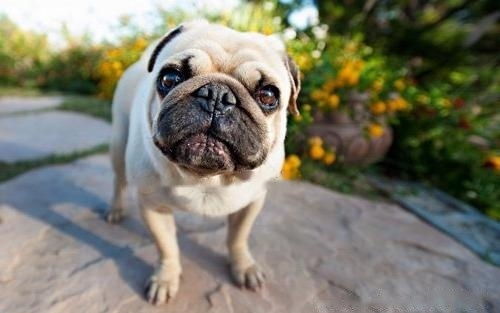Dog diarrhea is mainly caused by canine parvovirus, bacteria, food allergies, parasites, etc. Enteritis and colitis diarrhea are more common.
 pugdog
pugdogCauses of dog diarrhea
1. The dog has a cold: then please pay attention, now it is time to keep the dog warm and pay attention to the air in the house Temperature, do not let the dog enter the air-conditioned room at will, so that the dog has a moderate environment.
2. Overeating: Especially for large dogs, overeating dogs will also produce diarrhea and vomiting without digestion. So don't spoil the dog too much, be careful if there is a problem with the pet, don't give it too much, or it will be more troublesome for indigestion.
3. Food poisoning: eating things that should not be eaten, such as livers, chocolate or grapes, chicken bones, etc. of animals that are eaten too much.
4. Eating food eaten by humans: One is that the oil is too large, too salty, or there are a lot of things like onion and garlic used in the pot, which are forbidden for dogs to eat.
5. Unclean drinking water: Unclean water for dogs can also lead to diarrhea or drinking too cold. Change to clean water for the dog to drink.
6. Gastroenteritis, indigestion and other gastrointestinal problems: dogs have a bad stomach and are easy to picky eaters. Some probiotics, each dog's situation is different, so use dog probiotics for conditioning, some dogs recover in a week, some in a few days, it depends on the situation, everyone feed 2-3 small packets of probiotics every day Just for the dog to eat.
7. Infectious diseases: Diarrhea in the early stage, accompanied by vomiting. Appetite and lack of energy, vomiting of gastric mucosa in the middle stage, and watery excrement. In the later stage, the vomit is more viscous, the excrement is foul-smelling, and there is occasional incontinence. There is no way for us to come, it is better to see a doctor.
Dog diarrhea symptoms
1 Diarrhea due to food allergy: yellow or greenish-yellow stool, formed or soft, mixed with undigested food.
2 Parasitic diarrhea: the dogs were thin, mainly puppies aged 3--4 months, the initial diarrhea alternated with normal feces, and then loose stools were the mainstay. Coccidia, hookworm diarrhea with bloody stools.
3 Non-inflammatory colonic diarrhea: stools are sometimes soft and sometimes normal. During the same bowel movement, normal stools and loose stools may appear alternately. Large dogs are more frequent, the disease course is long, but there are no other abnormal symptoms.
4 Canine parvovirus enteritis: sick dog vomiting, bloody stool, fishy smell, elevated body temperature, not eating.
Diagnosis of Diarrhea in Dogs
Fecal examination can detect occult blood, detect worm eggs, and perform rapid diagnostic test for parvovirus and bacterial staining.
Dog Diarrhea Treatment
Diarrhea due to food allergies can be supplemented with nutrition and food changes, such as hypoallergenic dog food
Bacterial diarrhea can be taken orally with gentamicin (40,000-80,000 IU/time, 2 times/day). The treatment of parvoviral diarrhea is mainly symptomatic therapy and supportive therapy. Clinically, the following prescriptions can be referred to: compound normal saline, glucose injection, gentamicin or anthranofloxacin injection, ribavirin, vitamin C, dexamethasone
metasone, etc. Subcutaneous injection of hyperimmune serum, 1--2ML/KG body weight. Oral or intrarectal infusion of antiviral herbal decoction. Antidiarrheal can be taken orally with Vicondi (0.5-2 capsules/time, 2 times/day). Simultaneously with antiemetic hemostasis treatment puppies apply ATP and coenzyme A. Parasitic diarrhea should be dewormed and anti-inflammatory. When chronic colonic diarrhea is anti-inflammatory, sulfasalazine (40-60MG/KGBW.day, 4-6 times orally), tylosin and metronidazole (20-50MG/KGBW.day, orally) can be used.
![[Dog Training 5] The training method of pet dog dining etiquette](/static/img/12192/12192_1.jpg)




